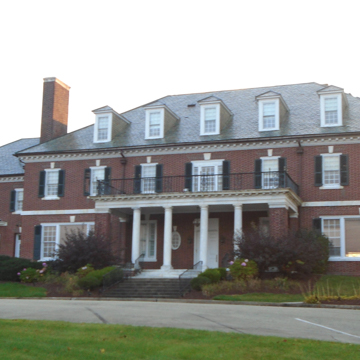You are here
The Inn at Georgian Place and Restaurant (Manor Hill, D. B. Zimmerman House)
Nationally known Philadelphia architect Horace Trumbauer (1869–1938) and his senior designer Julian Francis Abele (1881–1950) created this grand two-and-one-half-story brick Colonial Revival house. Trumbauer was known to depend heavily on the architects in his firm, and Abele, the only African American member of Philadelphia's T-Square Club, became the senior designer after 1908. Edward Hay Walker's obituary states that he also worked on this house. Coal baron Daniel B. Zimmerman commissioned the house, and, after his death, his daughter lived here until 1944, when it was sold to the first of many short-term owners. By 1990, the house had fallen into disrepair. In May 1993, it opened as a luxury bed-and-breakfast. Although the restoration was carefully done, the surrounding landscape was sacrificed in the process. The original site, a gentle tree-covered hill, was scraped away to leave the maroon brick house on a bald plateau of land, now surrounded by an expanse of outlet stores and parking lots. To the east is Lake Somerset, created in 1956 by the commonwealth's game commission.
Writing Credits
If SAH Archipedia has been useful to you, please consider supporting it.
SAH Archipedia tells the story of the United States through its buildings, landscapes, and cities. This freely available resource empowers the public with authoritative knowledge that deepens their understanding and appreciation of the built environment. But the Society of Architectural Historians, which created SAH Archipedia with University of Virginia Press, needs your support to maintain the high-caliber research, writing, photography, cartography, editing, design, and programming that make SAH Archipedia a trusted online resource available to all who value the history of place, heritage tourism, and learning.















